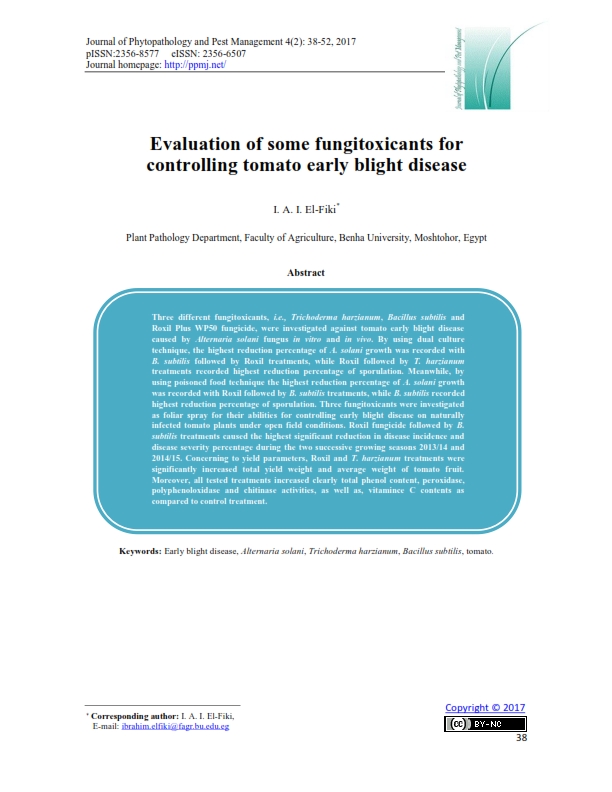Evaluation of some fungitoxicants for controlling tomato early blight disease
Keywords:
Early blight disease, Alternaria solani, Trichoderma harzianum, Bacillus subtilis, tomato.Abstract
Three different fungitoxicants, i.e., Trichoderma harzianum, Bacillus subtilis and Roxil Plus WP50 fungicide, were investigated against tomato early blight disease caused by Alternaria solani fungus in vitro and in vivo. By using dual culture technique, the highest reduction percentage of A. solani growth was recorded with B. subtilis followed by Roxil treatments, while Roxil followed by T. harzianum treatments recorded highest reduction percentage of sporulation. Meanwhile, by using poisoned food technique the highest reduction percentage of A. solani growth was recorded with Roxil followed by B. subtilis treatments, while B. subtilis recorded highest reduction percentage of sporulation. Three fungitoxicants were investigated as foliar spray for their abilities for controlling early blight disease on naturally infected tomato plants under open field conditions. Roxil fungicide followed by B. subtilis treatments caused the highest significant reduction in disease incidence and disease severity percentage during the two successive growing seasons 2013/14 and 2014/15. Concerning to yield parameters, Roxil and T. harzianum treatments were significantly increased total yield weight and average weight of tomato fruit. Moreover, all tested treatments increased clearly total phenol content, peroxidase, polyphenoloxidase and chitinase activities, as well as, vitamince C contents as compared to control treatment.
Metrics

Published
How to Cite
Issue
Section
License
Authors who publish with Journal of Phytopathology and Disease Management agree to the following terms:
- Authors retain copyright and grant the journal right of first publication with the work simultaneously licensed under a Creative Commons Attribution License that allows others to share the work with an acknowledgement of the work's authorship and initial publication in this journal.
- Authors retain copyright and grant the journal right of first publication with the work simultaneously licensed under the Creative Commons Attribution-Non Commercial License (CC BY-NC). This allows others to share the work with an acknowledgement of the work's authorship and initial publication in this journal.
- Archives of Agricultural Sciences Journal is an Open Access Journal, and articles published are distributed under the terms of the Creative Commons Attribution-Non Commercial License (CC BY-NC). Readers may copy, distribute, and display the work for non commercial purposes with the proper citation of the original work. However, the journal retains the right to exploit subsidiary rights on behalf of the authors.
- Authors are able to enter into separate, additional contractural arrangements for the non-exclusive distribution of the journal's published version of the work (e.g. post it to an institutional repository or publish it in a book), with an acknowledgement of its initial publication in this journal.
- Authors are permitted and encouraged to post their work online (e.g., in institutional repositories or on their website) prior to and during the submission process with full disclosure to the journal, as it can lead to productive exchanges, as well as earlier and greater citation of published work. Following publication in Archives of Agricultural Sciences Journal, the author should update the repository, and include a citation and link to the published work.
Click here for more information on Licensing policy
.png)




